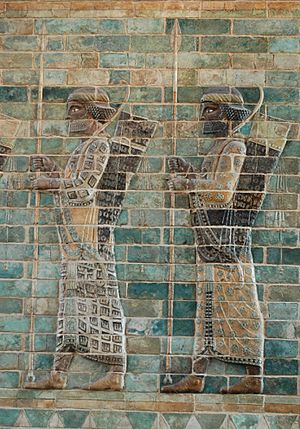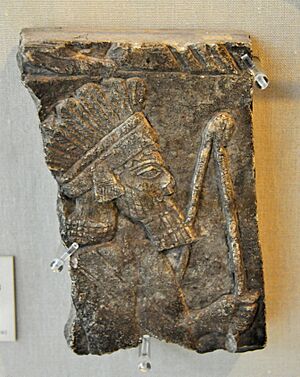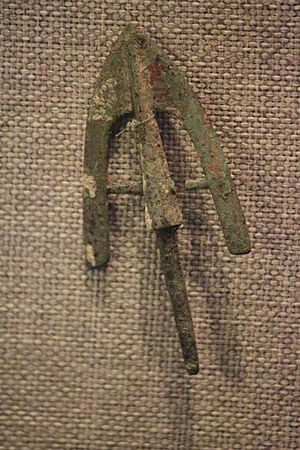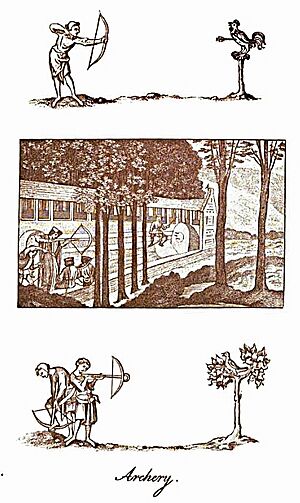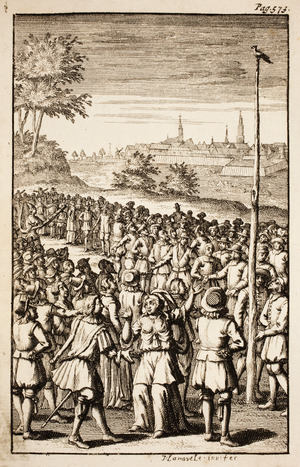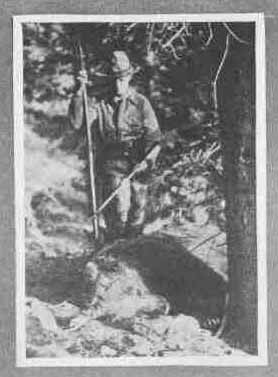History of archery facts for kids
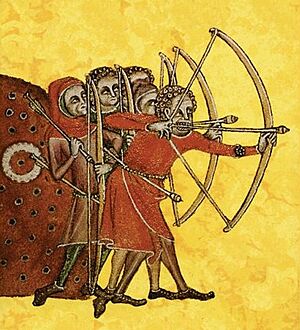
Archery is the skill of using a bow and arrow. It probably started in Africa about 70,000 years ago. People used bows and arrows for hunting and in warfare for thousands of years. From ancient times until the late 1800s, archery was very important. But then, new inventions like repeating firearms made bows less common in battles.
In ancient times, archers were a common part of armies. They fought on foot, from chariots, or while riding horses. Archery became super important in Europe during the later Middle Ages. Famous victories, like the Battle of Agincourt, showed how powerful the longbow could be.
Eventually, firearms replaced bows and arrows in Europe. As guns spread across the world, archery became less important in wars. But don't worry, archery is still practiced today! People enjoy it for hunting and as a fun target sport.
Contents
Archery Through Time
Ancient Origins of Bows and Arrows
The oldest signs of arrows come from South Africa. Scientists found arrowheads there that are about 72,000 to 60,000 years old. Some of these might have even had poison on them!
In France, tiny stone points from 54,000 years ago show damage from being used as weapons. Some are so small they could only have been arrowheads. These might have been used by the first modern humans leaving Africa.
Scientists also found arrowheads in Sri Lanka from 48,000 years ago. People there likely hunted monkeys and small animals with bows and arrows. In Kenya, obsidian blades found in human skeletons suggest arrows were used as weapons 10,000 years ago.
Rock art in the Sahara desert, from 5,000 years ago or more, shows people carrying bows. This tells us that bows were important tools for ancient people.
Early Bows in Europe and Beyond
Some possible bow pieces found in Germany are about 17,500 to 18,000 years old. In Switzerland, flint pieces found in a bear's bone suggest arrows were used 13,500 years ago.
The oldest complete bows were found in Denmark. They are about 8,000 years old and made of elm wood. These bows were strong and used for a long time.
Ancient cave paintings in Spain show battles between archers. These pictures give us a peek into how people fought long ago. Archery also reached the Americas around 6000 BC. It spread widely among indigenous peoples of North America by 500 AD.
Archery in the Stone and Bronze Ages
The oldest Stone Age bow in Europe was found in Spain. It's about 7,400 to 7,200 years old and made from yew wood. In the Stone Age and early Bronze Age, archery was a major way people fought each other. For example, at a place called Carn Brea, archaeologists found many arrowheads. This suggests a big group of archers attacked the settlement.
During the Middle Bronze Age, archers riding chariots became common in wars. This happened from Europe all the way to Asia and India. Later, mounted archery (shooting arrows from horseback) became super important for Eurasian nomad cultures. This skill helped them win many battles.
Archery in Ancient Civilizations
Many ancient civilizations used large numbers of archers in their armies. This included the Persians, Parthians, Egyptians, Nubians, Indians, Koreans, Chinese, and Japanese. Arrows were very effective against large groups of soldiers. The ancient Indian word for archery, dhanurveda, even came to mean martial arts in general.
Archery in North Africa
The ancient Egyptians started using bows and arrows about 5,000 years ago. It was common for both hunting and war. Some Egyptian gods were even linked to archery. The "Nine bows" was a symbol for Egypt's enemies.
Many archers serving Egypt were from Nubia. They were so good that Nubia was called "Ta-Seti," meaning "land of the bow," by the Egyptians.
Archery in Mesopotamia
The Assyrians and Babylonians used bows and arrows a lot for hunting and fighting. These empires had the first armies made only for war. This included soldiers trained as archers. They fought on foot and from chariots.
The Kassites used chariots with archers. Archery was key for light chariots in warfare. The Old Testament also talks about archery as a skill of the ancient Hebrews.
Archery in the Eurasian Steppes
The composite bow was first made in the Eurasian Steppes during the Bronze Age. From there, it spread across the world. Nomads from these steppes helped introduce the composite bow to other cultures.
The invention of spoke-wheeled chariots and the domestication of horses also happened here. This led to mounted archery, which changed warfare and archery forever.
Archery in India
The use of bows and arrows is well-known throughout Indian history. Ancient paintings show archery, and old texts like the Vedas talk about its importance. The Dhanurveda was an ancient book about the science of archery and its use in war. It described different bows, arrows, and how to train archers.
By 2000 BCE, composite bows were used in India. Archery was important for soldiers on foot and in chariots. It was also used by soldiers riding horses, camels, and elephants. The Arthashastra, a military book from the Maurya Empire, explains how important archery was. It even mentions an archery school that taught 103 princes!
Archery in Greco-Roman Times
The people of Crete were skilled archers, and other nations often hired them. When Alexander the Great invaded India, his army included archers.
Early Romans didn't have many archers. But as their empire grew, they hired archers from other lands. By the 4th century, Roman armies had many archers with powerful composite bows. Later, the Eastern Roman armies relied heavily on mounted archers.
Archery in East Asia
Archery was very important in ancient Chinese culture. Even Confucius, a famous philosopher, taught archery. In China, crossbows were also developed. Chinese writers said that crossbows helped them win battles against invaders.
Archery was one of the "Six Noble Arts" in ancient China. Being good at archery was seen as a great quality for Chinese emperors.
Archery in the Middle Ages
European Archery in Medieval Times
At the start of the Middle Ages, shortbows were used for hunting and war. They could kill or hurt an unarmored person up to 100 yards away. Vikings used shortbows a lot. At the Battle of Hastings, both sides had archers. The Norman archers helped win by shooting arrows high into the air, which went over shields and hit the enemy.
Around the 10th century, the crossbow arrived in Europe. Crossbows shot farther, were more accurate, and could pierce armor better than shortbows. But they were much slower to reload. They didn't need special skill or strength to use. Even though they were sometimes banned, crossbows were used in the early Crusades. They could shoot 300 yards and pierce armor.
The longbow appeared in Europe in the 13th century. It became famous in the 14th century. Longbow archers were usually peasants or farmers. The longbow had a similar range and power to the crossbow, but it could shoot much faster. It needed a lot of skill and strength to use. The English army famously used many longbow archers. Great victories like the Battle of Crecy and Battle of Agincourt made the English longbow legendary. Laws were even passed in England and Scotland to make sure people practiced archery.
Middle Eastern Archery
In the Middle East, the composite bow was the favorite bow in the later Middle Ages. It was stronger than the shortbow and could be fired from horseback. But it needed skilled makers and a lot of training to use well. The Byzantine Empire used many mounted archers from the 5th century. Their main soldiers, the Cataphracts, were armored horse archers.
Turkish tribes, like the Seljuk Turks, used mounted archers against European crusaders. Their archers were lighter and faster. They would shoot arrows at enemy soldiers, then ride away before the enemy could get close.
Asian Archery in the Middle Ages
The Mongol armies of Genghis Khan used mounted warriors almost entirely. They used the Mongol bow, a type of recurve composite bow, as their main weapon. These bows were very powerful and could shoot accurately up to 800 meters. Mongol warriors carried two bows: a long one for distance and a short one for close fighting. They also had different arrows for different uses, some that could pierce thick armor. Mongols trained with bows from a young age and competed in tournaments.
In Korea, archery skills were important for military exams. This helped Korean archery become a popular martial art. In China, archery was one of the "Six Noble Arts" of the Zhou dynasty.
The End of Archery in War
When firearms came along, bows slowly became less important in war. Even though archery was highly respected and fun, most cultures chose guns once they had them.
Early guns were slower to fire than bows. A longbow archer could shoot eight arrows in the time a gunner fired five shots. Guns were also easily affected by wet weather. However, guns could shoot much farther (up to 600 yards for a musket compared to 200 yards for a longbow). They also had much more power and could pierce steel armor without needing special strength from the soldier. Armies with guns had more firepower, and highly trained archers were no longer needed on the battlefield. The Battle of Cerignola in 1503 was the first major battle in Europe won mainly by using firearms.
The last regular army unit to use bows was in England, in 1642. The last time bows were used in a big battle in Britain was in Scotland in 1644.
Archery continued in some places where gun ownership was limited, like the Scottish Highlands. In Japan, the Tokugawa shogunate limited guns and encouraged traditional martial arts like archery.
In North America, the Comanche people continued to use mounted archery effectively, even against early guns. They were very skilled at hunting buffalo with bows from horseback.
Bows and arrows are still used today by some isolated cultures. For example, the Sentinelese people still use bows as part of their traditional way of life.
Archery as a Modern Sport
In Britain, archery became a popular hobby for upper-class people from about 1780 to 1840. Early archery clubs, like the Finsbury Archers, held competitions. The Company of Scottish Archers, formed in 1676, is one of the oldest sports groups in the world.
Archery became a fancy social event for rich people, with flags, music, and salutes. After the Napoleonic Wars, it became popular with all classes. Books like Sir Walter Scott's Ivanhoe helped make archery seem heroic and fun.
Archery Becomes a Modern Sport
In the 1840s, people started turning archery into a modern sport. The first big archery competition was held in York in 1844. The rules were standardized into the 'York Round,' which involved shooting at targets at 60, 80, and 100 yards. Horace A. Ford helped improve archery standards and won the Grand National 11 times in a row.
By the late 1800s, fewer people were doing archery as other sports like croquet and tennis became popular. But archery was still included in the 1900 Paris Olympics.
In the United States, traditional archery was revived in the early 1900s. A Native American man named Ishi shared his traditional archery skills with a doctor named Saxton Pope. Pope then helped make these skills popular.
In Korea, archery became a healthy pastime thanks to Emperor Gojong. It's now a popular modern sport there. The Japanese still make and use their unique traditional bows called yumi.
In modern times, mounted archery is a popular sport in Hungary and some Asian countries. Archery is also the national sport of the Kingdom of Bhutan.
Since the 1920s, engineers have helped create new types of bows, like the modern recurve and compound bow. These are now the most common bows in Western archery. Traditional bows are less common but are still enjoyed by many.
See also


